In the rapidly evolving telecommunications landscape, core network cloudification and virtualization represent transformative gateways for telcos and media providers. The shift of mobile networks to the cloud (and especially the adoption of a cloud-native 5G core) is a major force driving telco cloud transformation. With the network core already in transition, telcos are now expanding cloudification to edge, radio, and transport networks.
This shift fuels practical applications like automated smart factories, private 5G networks in vital sectors, and predictive maintenance through sensor networks. Benefiting from 5G’s high speed and low delay, cloud-native networks become a powerful replacement for older systems driven by 5G standalone core architecture. Telcos are drawn to this transformation not just to meet rising costs but also to tap into the inherent benefits of cloud-native networks in transforming how telecommunications work.
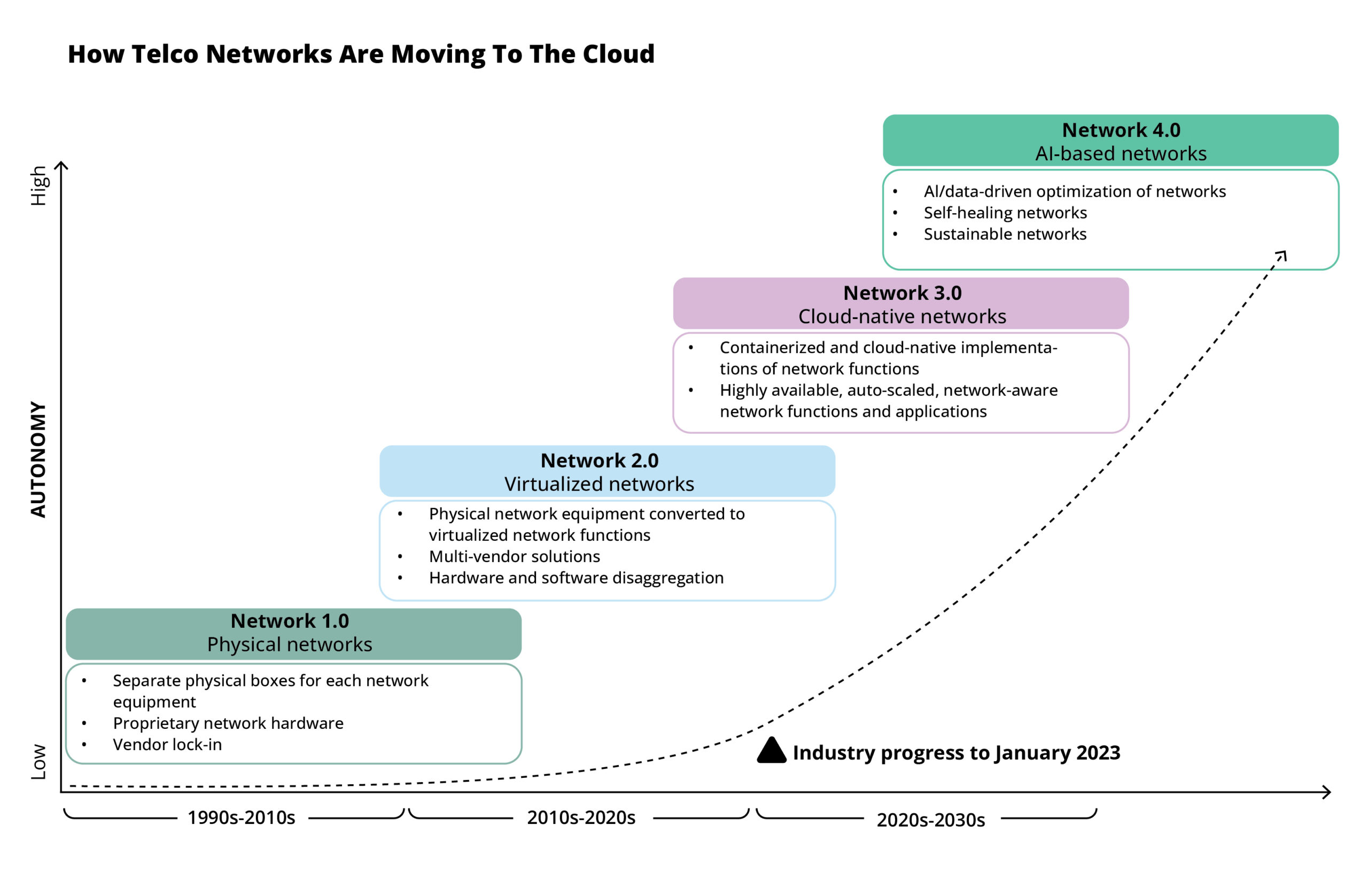
Source: Capgemini
While challenges persist, such as monetizing 5G services and ensuring the reliability of certain network functions on cloud infrastructure, the potential benefits of transitioning to cloud-native networks are too significant to ignore. Overcoming these challenges requires not only technical adjustments but also shifts in business, operational, and recruitment models, emphasizing the need for a sensitive cultural transformation within the organization. As telcos consider the inevitability of this transformation, key questions emerge: Why embrace cloudification of the telecom network? What investments should we make? How can we maximize cloud benefits in telecommunications?
Future perspectives of telco cloud growth
The telecom cloud sector is on track for robust 50% growth in the next five years, with 31% of global telco network capacity (across 4G/5G networks) currently serviced by cloud-based platforms and this figure projected to reach 46% at an 8% CAGR. Concurrently, 29% of global network functions are virtualized, driven by scalability (52%), reduced network complexity (48%), and increased operational efficiency (39%).
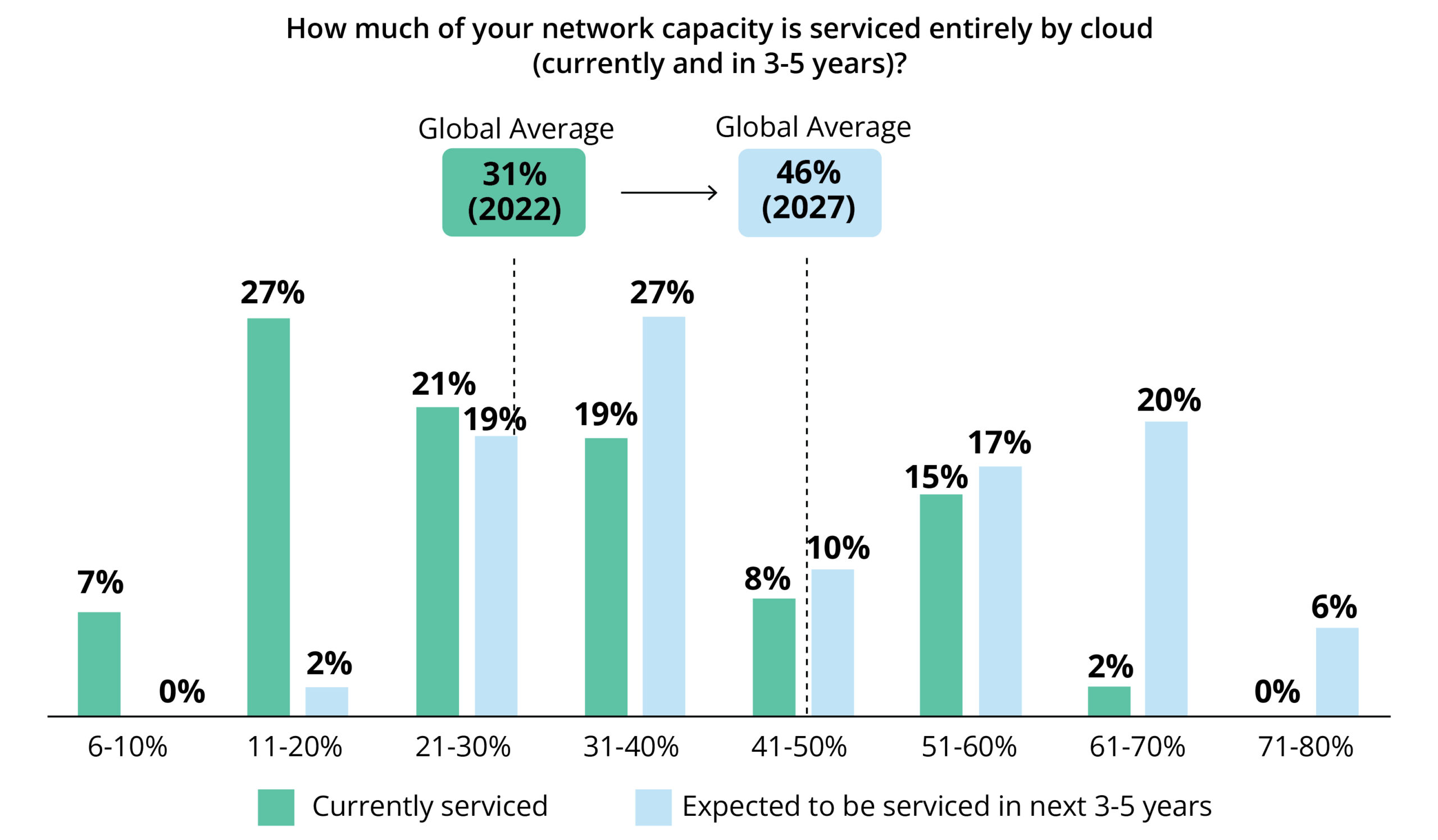
Source: Capgemini
Private cloud is emerging as the favored deployment model, embraced by nine in ten telcos across network domains. Over the next five years, telcos plan to invest an average of $206 million per year in the cloud, realizing substantial financial benefits including potential cost savings of $260 million to $380 million per year and additional revenue ranging from $110 million to $210 million.
Beyond financial gains, telcos undergoing cloud transformation anticipate a 5% reduction in greenhouse gas emissions over the next three to five years. The success of leading telecom companies in harnessing the cloud underscores the importance of adopting a five-point plan, emphasizing early adoption, comprehensive strategies, efficient monetization, talent and automation use, and strategic partnerships. This transition to the cloud signifies not just a technological shift but a cultural transformation within organizations, ensuring a holistic approach to innovation and agility.
Telecom cloud ecosystem: components and architecture
Embarking on telco cloudification, a transformative journey for communication service providers (CSPs), involves a fundamental shift without the need for extensive infrastructure changes. At its core, telecom cloud services refers to using network resources and services in the cloud, offering private, public, or hybrid solutions. These cloud levels — cloud-enabled, cloud-based, and cloud-native — aim to optimize connectivity services and cloud offerings (IaaS, PaaS, SaaS).
Constructing the telco cloud involves crucial components and architectural steps. Initially, networks undergo virtualization and softwarization through network functions virtualization (NFV) and software defined networks (SDN). NFV breaks down network functions into virtualized network functions (VNFs), replacing traditional hardware with flexible alternatives. Simultaneously, SDN streamlines network control, enabling centralized routing through software. The collaboration of NFV and SDN forms the backbone of an agile architecture, essential for effective cloudification of telecom networks.
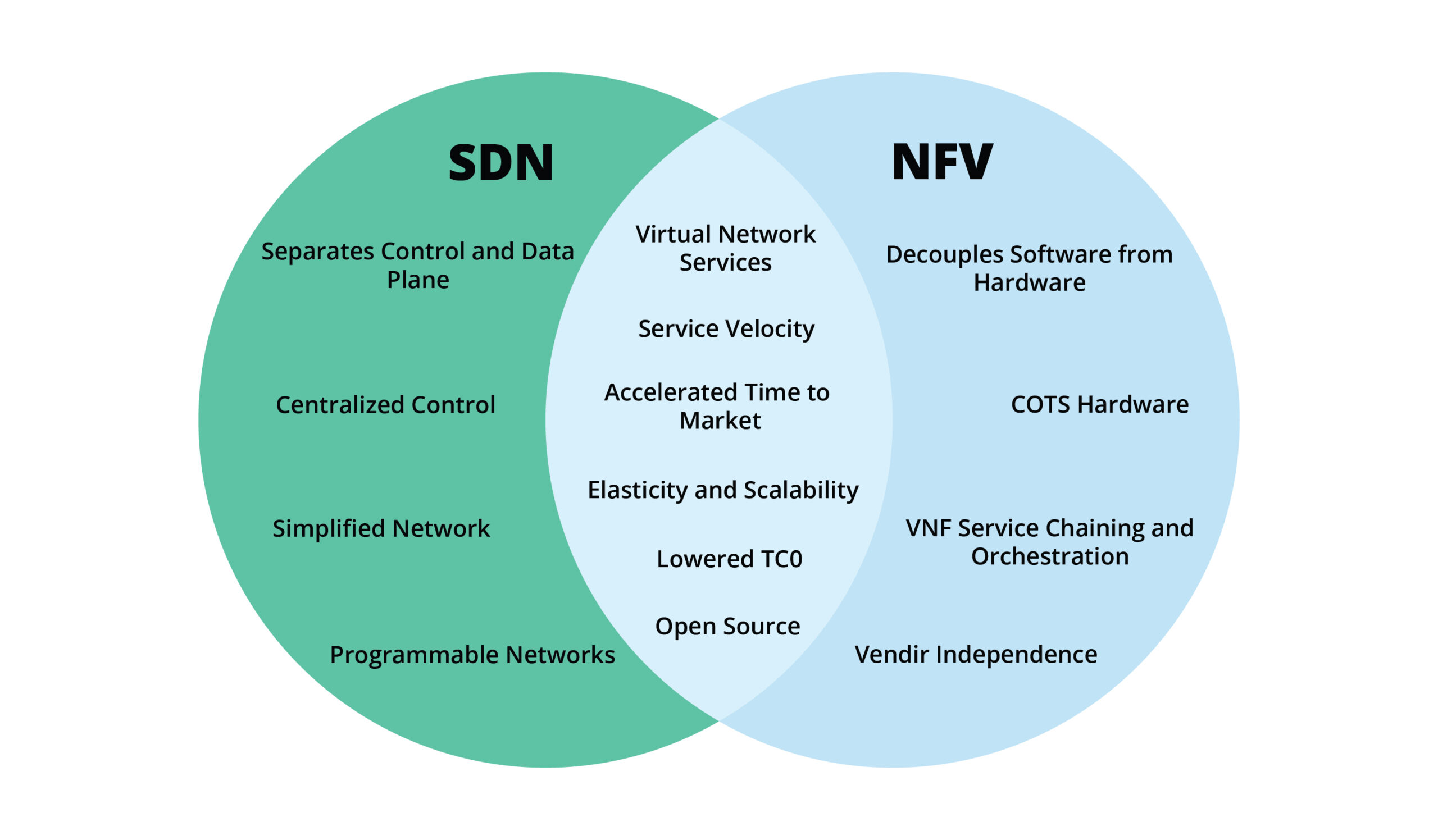
Source: Stanton Chase
This cloudification journey extends to the edge, incorporating edge computing to address challenges posed by the Internet of Things (IoT). Edge clouds, composed of local micro data centers, optimize network performance by handling localized tasks. The success behind cloudification of telcos lies in aligning strategies with business needs, adopting NFV and SDN, integrating open-source software, embracing practices like DevOps, and incorporating automation and artificial intelligence. This transition positions CSPs as digital service providers (DSPs), streamlining new service design and rollout, unlocking opportunities presented by 5G and IoT, and contributing to sustained growth in the telecom sector.

Source: Stanton Chase
In essence, embracing telco cloudification not only simplifies network infrastructure but also proves advantageous for businesses. Cloud solutions offer flexibility, scalability, and cost-effectiveness, allowing CSPs to innovate without the burden of extensive hardware changes. The cloud’s inherent benefits underscore its pivotal role in enhancing connectivity services and fostering digital transformation.
Leveraging cloud potential for telcos
Our extensive collaboration with major global telco operators in their cloud journey and in-depth research into telco cloud solutions have led us to develop a five-point plan, providing a roadmap for telcos to fully leverage cloud potential.
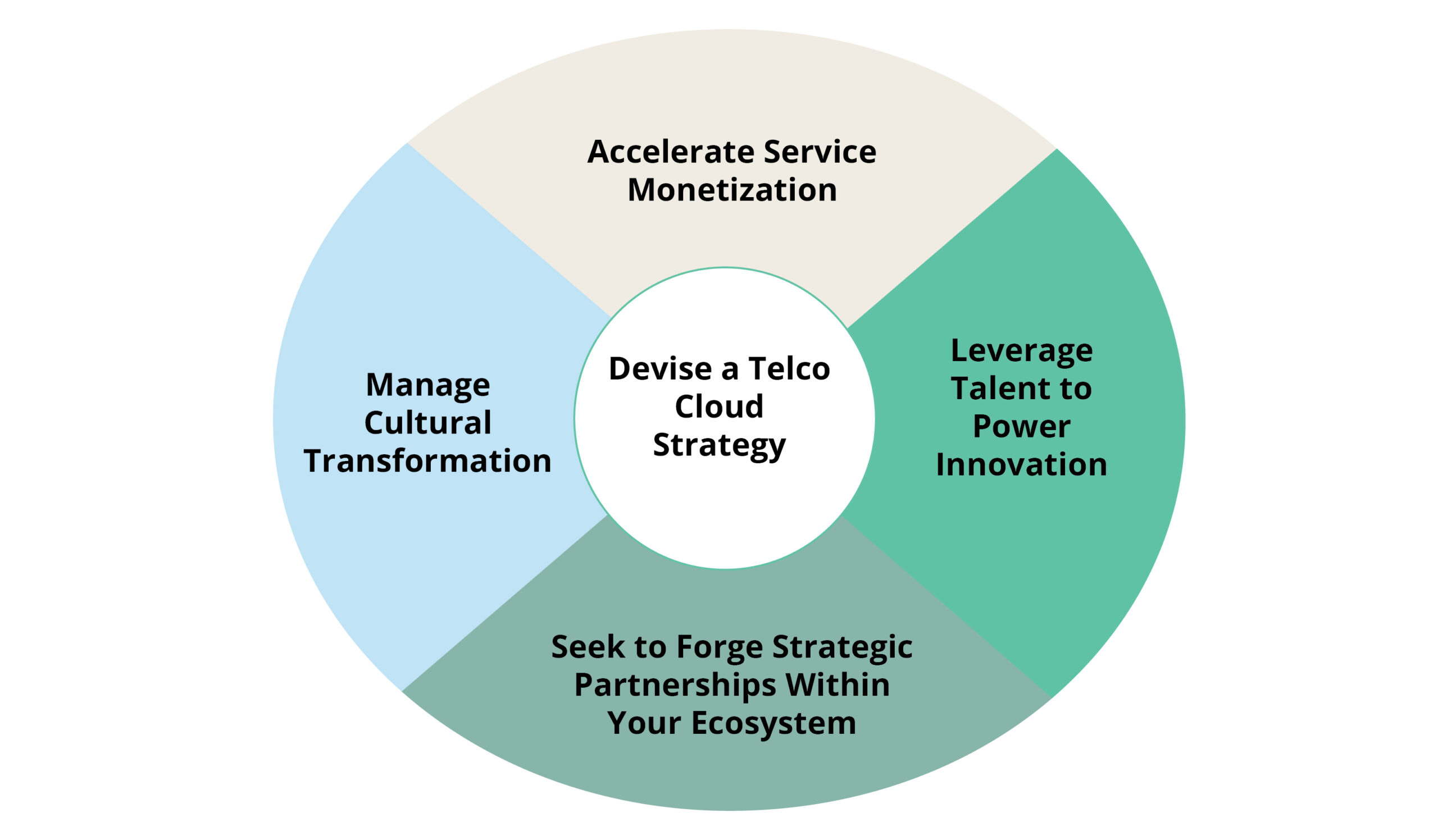
Source: Capgemini
I. Devise a comprehensive telco cloud strategy
According to Capgemini survey, approximately 9% of telco executives reported having a comprehensive telco cloud strategy. Fifty-two percent stated that their firms had some telco cloud initiatives but lacked a comprehensive strategy. Delaying cloud transformation could place CSPs at a significant disadvantage. Deutsche Telekom exemplifies a strategic approach, systematically digitalizing its operations and evolving into a global “digital telco.” The timing of telco cloud transformation is crucial, often aligning with the deployment of the 5G standalone (SA) core, which acts as a catalyst for cloud implementation.
II. Aim for rapid, efficient monetization of new services
Swiftly monetizing 5G services is paramount for recouping telco cloud and 5G technology investments. Service monetization should be a core element of the telco cloud strategy, involving strategic stages such as devising a strategy, identifying core services to monetize, assessing market demand, and preparing infrastructure for scalable cloud-based services. Early market capture, exemplified by partnerships like that between Orange and Nokia, who deployed a 4G/5G private network with network slicing, underscores the importance of innovative service offerings.
III. Leverage new talent and automation for innovation and agility
The skills required for successful cloud transformation often necessitate significant investment in upskilling, reskilling, and hiring. Telcos plan to invest 8% of their overall cloud transformation budgets towards workforce-related expenses, emphasizing talent acquisition in areas like Kubernetes, DevOps, cloud management, and data analytics. Automation, a significant outcome of telco cloud transformation, not only enhances operational efficiency but also directs the network workforce towards innovation and agility.

Source: Capgemini
IV. Seek to forge strategic partnerships within your ecosystem
Telco cloud transformation opens avenues for multiple vendors and partners, emphasizing the need for a symbiotic relationship. Orchestrating ecosystem partnerships requires clear governance and terms of agreement with clarity on cloud costs and their evolution. Assigning a leader responsible for end-to-end transformation, along with systematic governance involving representatives from all partners, ensures alignment and prioritization.
V. Manage cultural alongside technological transformation
Cultural challenges, cited by 52% of telco executives as the biggest barrier to telco cloud transformation, underscore the need for a fundamental rethinking of organizational culture. Regulatory concerns, data protection, cloud sovereignty, and cybersecurity are additional top concerns. Change management, critical for a smooth transition, is an investment area often overlooked, with only 18% of executives considering it among their top three cloud investment priorities. As telcos evolve, reorganization and collaboration across functional boundaries become imperative.
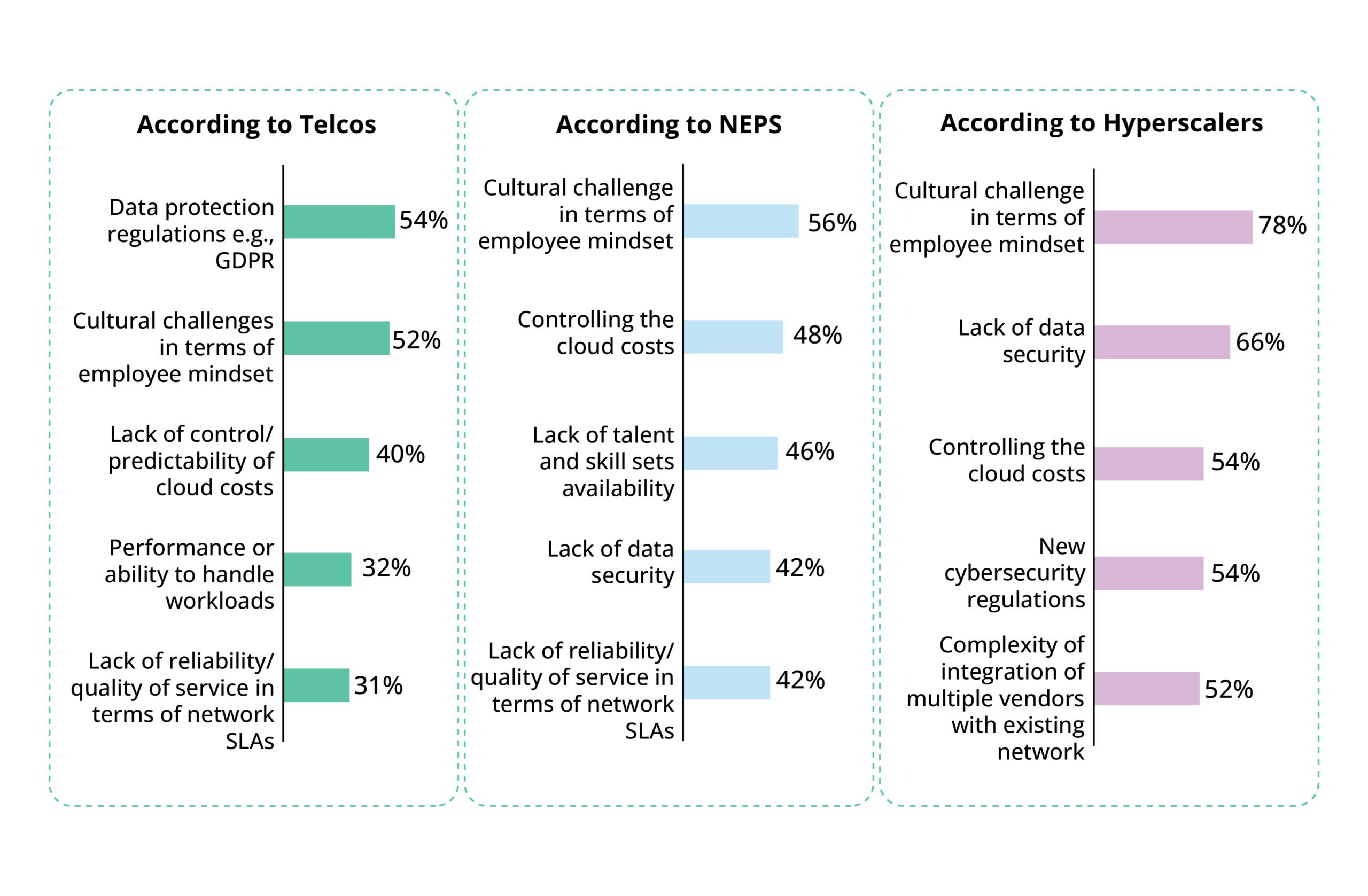
Source: Capgemini
This holistic five-point plan serves as a guide for telcos in navigating the dynamic cloud landscape to ensure a strategic, agile, and culturally aligned transformation.
Unlocking telco cloud innovation: Landscape overview
In the dynamic realm of telecommunications, the evolution towards telco cloud is reshaping industry landscapes, and within this transformative journey, telcos exhibit varying levels of readiness and strategic implementation. A comprehensive analysis classifies telcos into early adopters, telco-cloud followers, and laggards, revealing a spectrum of preparedness for cloud-driven transformation.
Early adopters, constituting 23% of telcos, stand at the forefront, showcasing a holistic telco cloud strategy, substantial network function virtualization, and a short-term timeline for timeline for transitioning network capacity to the cloud. Their strategic prowess not only propels the state of their transformation but also translates into tangible benefits, focused investments, and ambitious aspirations, underscoring their pivotal role in shaping the telco cloud narrative.

Source: Capgemini
The benefits realized by early adopters surpass those of their counterparts, with enhanced risk-sharing capabilities and a holistic approach to innovation through research and development (R&D), cloud management, and product/service innovation. As we delve into case studies, it becomes evident that early adopters are not merely pioneers but catalysts, driving innovation and setting benchmarks for the industry.
Realizing potential: Case studies in telco cloud innovation
The cloud is revolutionizing telecommunications, reshaping businesses, and fueling innovation. These real-world case studies, guided by a team of seasoned Intellias experts, reveal how the cloud becomes a strategic cornerstone in telco providers’ journeys of transformation.
Intellias collaborated with a global software solution integrator and prominent German telecommunications service provider to migrate business support systems (BSS) to the cloud, accelerating digitalization, optimizing operations, and reducing costs. By leveraging cloud-based solutions, a microservices architecture, and multi-cloud deployment, the initiative aims to achieve leaner, more efficient IT infrastructure, significantly decrease time to market for telecom products, and enhance customer satisfaction. This case exemplifies the transformative power of cloud technology in the telecommunications industry, facilitated by a dedicated team of experts.
Intellias worked with a leading national telecom provider to assess the feasibility of migrating to Microsoft Azure, aiming to modernize operations and optimize infrastructure costs. In a successful partnership endorsed by Microsoft, Intellias developed a proof of concept (PoC) for continuous integration and delivery (CI/CD), evaluating performance metrics and cost efficiency as part of Azure migration services. By leveraging Intellias expertise and Microsoft’s best-of-breed cloud services, the initiative demonstrated the potential for infrastructure scalability, reduced costs, and improved flexibility, paving the way for a future-proof telecom ecosystem.
Intellias partnered with a major national telecommunications company to assess the feasibility of migrating data processing and analytics from on-premises servers to the AWS cloud. By designing a customized cloud solution architecture, measuring performance metrics, and estimating infrastructure costs, the project aimed to streamline data processing and business intelligence systems, paving the way for cost-efficient scalability and innovation in the telecom industry. This case study showcases the successful collaboration between Intellias, AWS, and the telecom giant, setting the stage for future opportunities and advancements.
Discover how our collaboration with a US cloud voice company has revolutionized the telecom industry by migrating legacy on-premises software to a unified cloud-based communications platform. This case study showcases our role in transforming traditional voice solutions into an integrated UCaaS cloud platform, delivering innovative communication and collaboration features, boosting revenue, and positioning our client as a market leader in the UCaaS space.
Learn how Intellias collaborated with Playbuzz, a global multimedia storytelling platform, to supercharge their digital content distribution system. Through an augmented engineering team and targeted expertise, we enabled Playbuzz to innovate and maintain their industry-leading position, serving over 300 million active monthly users and 10,000+ publishers worldwide.
Intellias collaborated with a leading Eastern European telecommunications operator to create a custom telecom marketplace using composable commerce technology. This innovative platform aimed to improve customer interactions, stand out in a competitive market, and generate new revenue streams. The project involved selecting the right technology stack, onboarding vendors, implementing secure payment systems, and continuously enhancing the platform for a successful marketplace launch.
Find out how Intellias helped a leading Middle Eastern telecommunications provider revolutionize its data center operations with a tailored data center infrastructure management (DCIM) system. By seamlessly integrating existing hardware, monitoring energy efficiency, and providing comprehensive insights, our DCIM solution empowered the client to enhance service delivery, improve infrastructure visibility, and drive operational excellence in the dynamic telecom market.
Why partner with Intellias?
Intellias offers a unique blend of integrated DevOps and cloud consulting services that empowers businesses to unlock the full potential of cloud technology. Our approach revolves around symbiotic relationships, delivering value at the speed and scale your business demands. Through seamless integration and process automation, enhanced by the power of cloud solutions, we facilitate the transition to a culture of continuous progress.
Our expertise addresses a spectrum of challenges, including optimizing productivity and costs. We enable access to scalable computing resources on demand, eliminating the need for hefty upfront infrastructure investments. Embracing agility and automation is a key facet of our services, allowing organizations to adapt to changing demands while efficiently migrating legacy infrastructure to the cloud. With Intellias, scaling with cloud-native apps is seamless, ensuring enhanced fault tolerance and the ability to effortlessly meet growing business demands. Plus, our pay-as-you-go approach helps eliminate the inefficiencies of over-provisioning and optimizes capacity management.
Intellias leverages years of experience in cloud computing and collaborates with world-leading cloud providers including AWS, Microsoft Azure, and Google Cloud. We empower companies to harness the full potential of high-performing public, private, and hybrid cloud environments. Our cloud implementation services are designed to future-proof IT investments, ensuring optimized performance, organizational accountability, and cost-effectiveness in a crowded market. Partner with Intellias and embark on a journey towards cloudification of telcos that paves the way for innovation and sustainable growth.
Bottom line
The telecom landscape is undergoing a profound transformation, setting the stage for a future where intelligent software takes the reins, managing networks almost autonomously. Artificial intelligence and machine learning are at the forefront, fine-tuning systems and orchestrating real-time traffic flows. Sustainability is a central theme, with a growing emphasis on energy-efficient, renewable-powered network resources.
This evolution is already in motion, with the introduction of cloud-native network functions marking a significant departure from the traditional reliance on physical infrastructure. The industry is shifting from capital-intensive investments to a more flexible operational expenditure (OPEX) model. Fixed-price structures are giving way to adaptable as-a-service offerings. Innovative telecom industry pioneers have embraced this change and are already reaping the rewards. Don’t miss out on this transformative shift; be an early adopter and seize the opportunities now.




